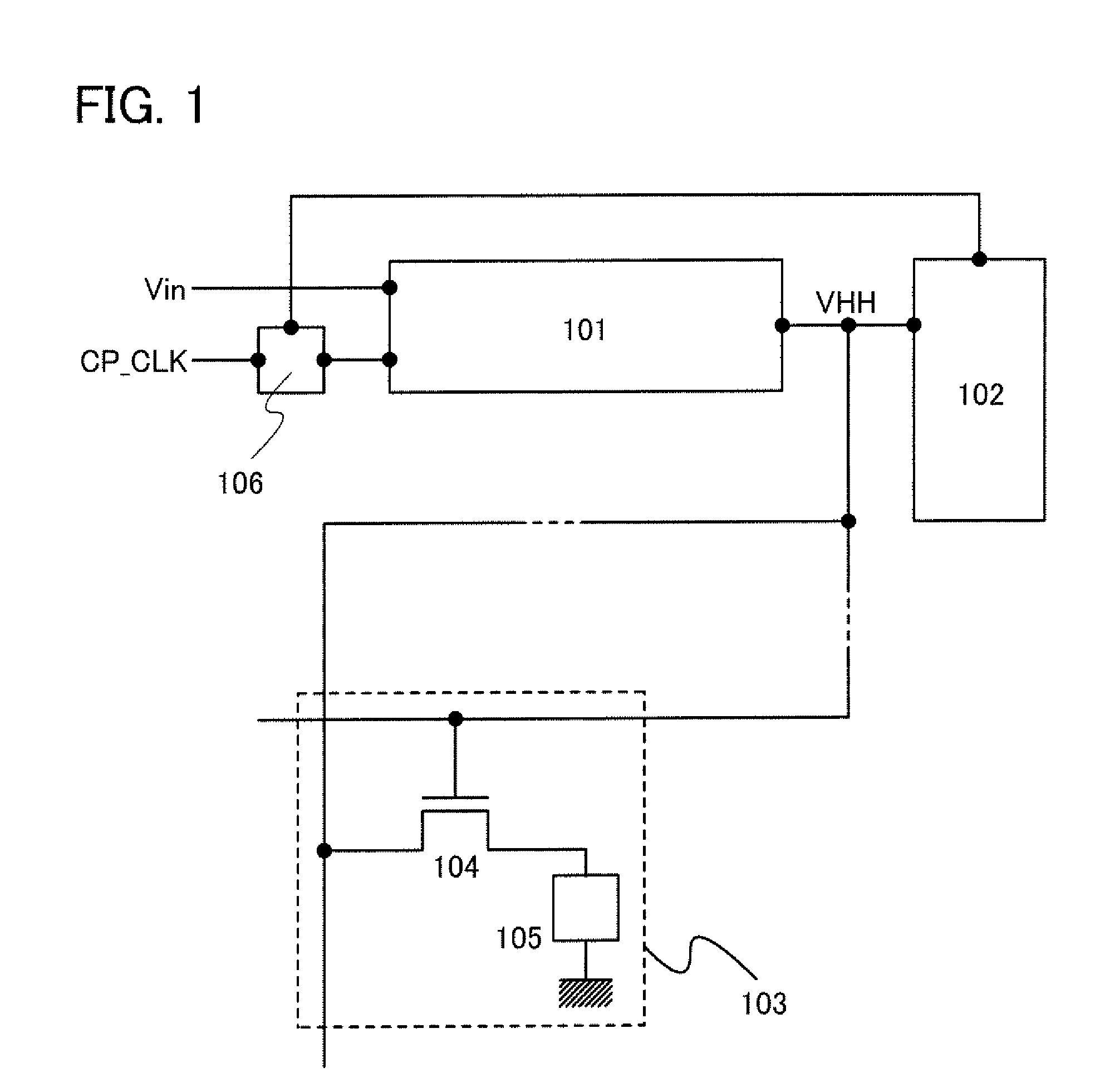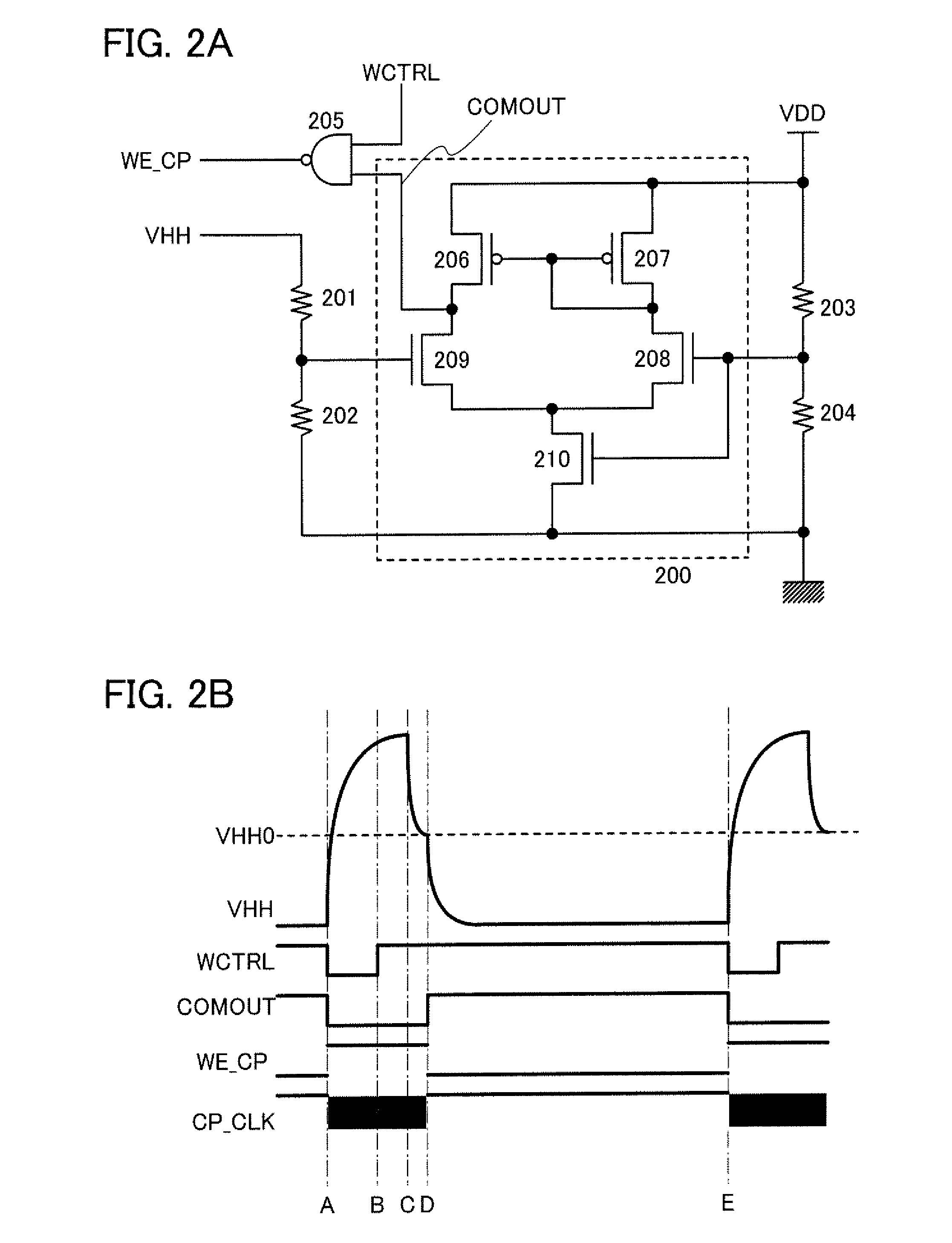Semiconductor memory device and data processing device
- Summary
- Abstract
- Description
- Claims
- Application Information
AI Technical Summary
Benefits of technology
Problems solved by technology
Method used
Image
Examples
embodiment 1
[0048]In Embodiment 1, an example of a structure of a semiconductor memory device will be described with reference to a drawing.
[0049]FIG. 1 is a block diagram of one example of a memory module on which an OTP memory is mounted. The memory module in FIG. 1 has a function of feeding back a change in output voltage of a boosting circuit in writing to a signal input to the boosting circuit. In the block diagram in FIG. 1, a boosting circuit 101, a monitor circuit 102, a memory cell 103, and a control circuit 106 are shown. The memory cell 103 includes a transistor 104 and a memory element 105. Although not shown, a capacitor may be connected in parallel to the memory element 105 in order to improve a writing yield.
[0050]In a writing operation, the boosting circuit 101 boosts an input voltage (Vin) using a clock signal (CP_CLK) and outputs the boosted voltage as an output voltage (VHH). The output voltage (VHH) of the boosting circuit 101 is applied to the memory element 105 through the...
embodiment 2
[0054]In Embodiment 2, a more specific structure of a semiconductor memory device will be described with reference to drawings.
[0055]FIG. 2A is a circuit diagram showing an example of a monitor circuit mounted on the memory module described in Embodiment 1. The circuit in FIG. 2A includes a comparator 200, resistors 201 and 202 for dividing the output voltage (VHH) of the boosting circuit to be input to the comparator 200, resistors 203 and 204 for dividing a power supply voltage (VDD) to be input to the comparator 200 for comparison with the output voltage (VHH) of the boosting circuit, and a NAND gate 205 which outputs the logical NAND of an output (COMOUT) of the comparator 200 and a writing control signal (WCTRL). The comparator 200 includes transistors 206 to 210.
[0056]The comparator 200 compares voltages applied to two input terminals (here, a gate electrode of the transistor 208 and a gate electrode of the transistor 209). When one of the voltages is higher than the other, th...
embodiment 3
[0071]In Embodiment 3, a more specific structure of a semiconductor memory device according to one embodiment of the present invention will be described with reference to drawings.
[0072]FIG. 6 is a block diagram of an example of a memory circuit in which memory cells and circuits necessary for driving the memory cells are modularized. As illustrated in FIG. 6, a memory circuit 3000 includes a memory cell array 3001, a column decoder 3002, a row decoder 3003, an address selector 3004, a selector 3005, a reading / writing circuit 3006, a boosting circuit 3007, and a monitor circuit 3008. Here, the memory cell array 3001 includes a plurality of memory cells arranged in a matrix.
[0073]Next, the operation of the memory circuit 3000 will be described. To the memory circuit 3000, a read enable signal (RE), a write enable signal (WE), an address signal (address), and a clock signal (CP_CLK) which is supplied to the boosting circuit are input as operation signals, and the input voltage (Vin) f...
PUM
 Login to View More
Login to View More Abstract
Description
Claims
Application Information
 Login to View More
Login to View More - R&D
- Intellectual Property
- Life Sciences
- Materials
- Tech Scout
- Unparalleled Data Quality
- Higher Quality Content
- 60% Fewer Hallucinations
Browse by: Latest US Patents, China's latest patents, Technical Efficacy Thesaurus, Application Domain, Technology Topic, Popular Technical Reports.
© 2025 PatSnap. All rights reserved.Legal|Privacy policy|Modern Slavery Act Transparency Statement|Sitemap|About US| Contact US: help@patsnap.com



